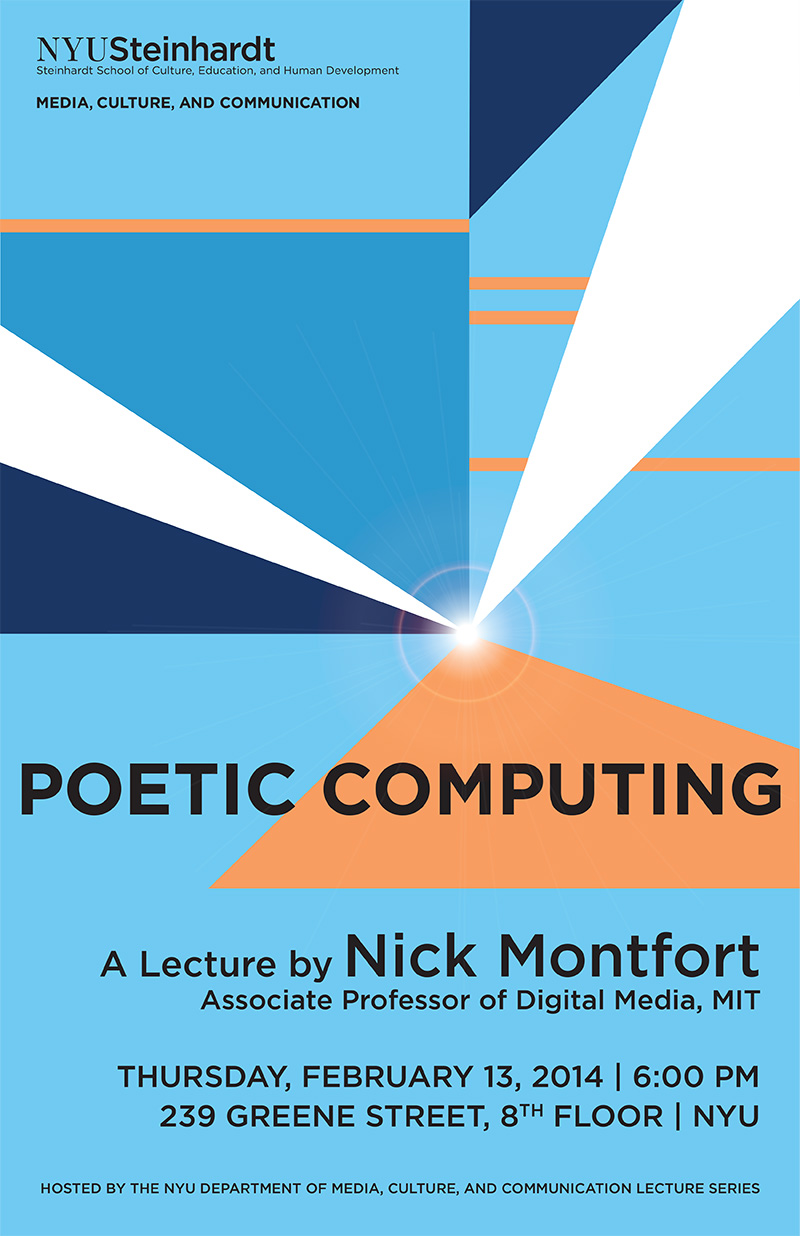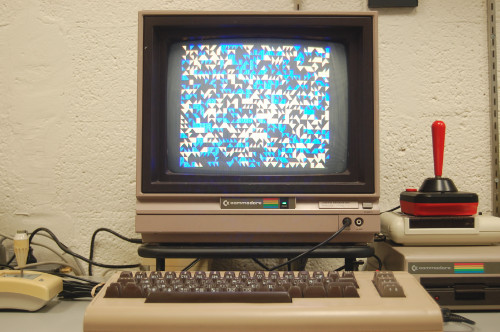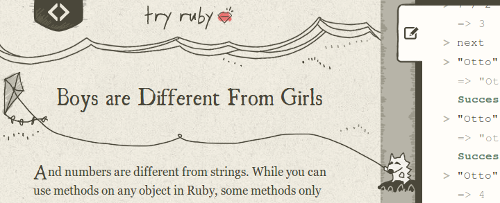Here’s the Boston.com article on our exhibit “Programs at an Exhibition,” which opens Thursday (March 6). Hope to see you at the opening, which is 6pm-9pm.
“Programs at an Exhibition” March 6-16
Nick Montfort & Páll Thayer
Programs at an Exhibition
At the Boston Cyberarts Gallery
141 Green Street, Jamaica Plain, MA 02130
Located in the Green Street T Station on the Orange Line
Phone number: 617-522-6710
The exhibit runs March 6 through March 16.
Opening: 6pm-9pm, Thursday March 6.
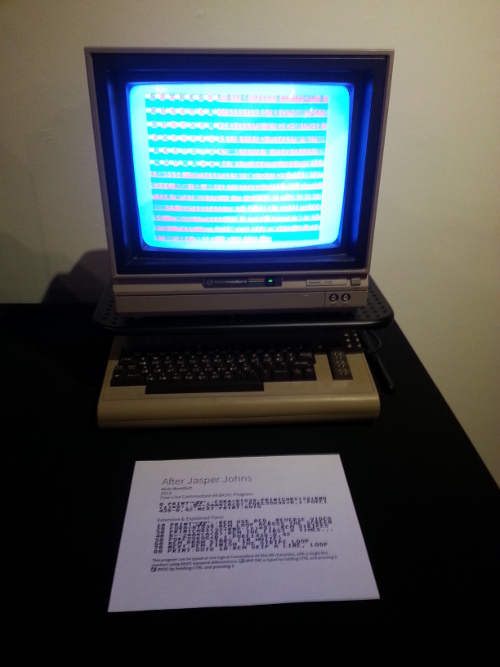
Part of the life of remarkable artworks is that they are appropriated, transformed, and made new. In Programs at an Exhibition, two artists who use code and computation as their medium continue the sort of work others have done by representing visual art as music, by recreating performance pieces in Second Life, and by painting a mustache and goatee on a reproduction of the Mona Lisa. Programs at an Exhibition presents computer programs, written in Perl and Commodore 64 BASIC, each running on its own dedicated computer. The 20th century artworks reenvisioned in these programs include some by painters and visual artists, but also include performances by Joseph Beuys and Vito Acconci. All of the underlying code is made available for gallery visitors to read; they are even welcome to take it home, type it in, and run or rework these programs themselves.
The programs (Commodore 64 BASIC by Nick Montfort, Perl by Páll Thayer) re-create aspects of the concepts and artistic processes that underlie well-known artworks, not just the visual appearance of those works. They participate in popular and “recreational” programming traditions of the sort that people have read about in magazines of the 1970s and 1980s, including Creative Computing. Programmers working in these traditions share code, and they also share an admiration for beautiful output. By celebrating such practices, the exhibit relates to the history of art as well as to the ideals of free software and to the productions of the demoscene. By encouraging gallery visitors to explore programming in the context of contemporary art and the work of specific artists, the exhibit offers a way to make connections between well-known art history and the vibrant, but less widely-known, creative programming practices that have been taken up in recent decades by popular computer users, professional programmers, and artists.
The Perl programs in the exhibit are from Microcodes, a series of very small code-based artworks that Páll Thayer began in 2009. Each one is a fully contained work of art. The conceptual meaning of each piece is revealed through the combination of the title, the code and the results of running them on a computer. Many contemporary programmers view Perl as a “dated” language that saw its heyday in the early ages of the World Wide Web as the primary language used to combine websites with databases. Perl was originally developed by Larry Wall, whose primary interest was to develop a language for parsing text. Because of his background in linguistics, he also wanted the language to have a certain degree of flexibility which has contributed to its motto, “There’s more than one way to do it.” “That motto, ‘TMTOWTDI,’ makes Perl challenging for professional programers who have to take over other’s people code and may struggle to make sense of it,” Thayer said. “But it’s one of the main reasons that Perl, a very expressive programming language, appealed to me in developing this project. This flexibility encouraged Perl programmers to explore individual creative expression in the writing of functional code.”
“Páll’s work in Microcodes engages explicitly with the way computer programs are read by people and hwo they have meanings to those trying to understand them, modify them, debug them, and develop them further,” Nick Montfort said. “The Perl programs in Microcodes are quite readerly when compared to my BASIC programs. I’ve tried to engage with a related, but different documented historical tradition — the one-line BASIC program — as it works in a particular computer, the Commodore 64, and to dive into what that particular computer can do using a very limited amount of code, given these many formal, material, and historical specifics. Because my programs are harder to understand, even though they are written in a more populist programming language, I’m including versions of the program that I have rewritten in a clearer form and that include comments.” Montfort’s related projects include a collaborative book, written with nine others in a single voice, that focuses on a particular Commodore 64 BASIC one-liner. The book, published in 2012, is named after the program that is its focus, 10 PRINT CHR$(205.5+RND(1)); : GOTO 10. Montfort also writes short programs to generate poetry. These include two collections of Perl programs that are constrained in size: his ppg256 series of 256-character programs, and a set of 32-character concrete poetry generators, Concrete Perl. His book #! (pronounced “Shebang”) collects these and other poetry generators, along with their output, and is forthcoming from Counterpath Press.
Nick Montfort develops literary generators and other computational art and poetry, and has participated in dozens of collaborations. He is associate professor of digital media at MIT and faculty advisor for the Electronic Literature Organization, whose Electronic Literature Collection Volume 1 he co-edited. Montfort wrote the book of poems Riddle & Bind and co-wrote 2002: A Palindrome Story with William Gillespie. The MIT Press has published four of Montfort’s collaborative and individually-authored books: The New Media Reader (co-edited with Noah Wardrip-Fruin), Twisty Little Passages, Racing the Beam (co-authored with Ian Bogost), and most recently 10 PRINT CHR$(205.5+RND(1)); : GOTO 10, a collaboration with Patsy Baudoin, John Bell, Ian Bogost, Jeremy Douglass, Mark C. Marino, Michael Mateas, Casey Reas, Mark Sample, and Noah Vawter that Montfort organized. Nick Montfort’s site, with his digital poems and a link to a free PDF of 10 PRINT: http://nickm.com
Páll Thayer is an Icelandic/American artist working primarily with computers and the Internet. He is a devout follower of open-source culture. His work is developed using open-source tools and source code for his projects is released under a GPL license. His work has been exhibited at galleries and festivals around the world with solo shows in Iceland, Sweden, and New York and notable group shows in the US, Canada, Finland, Germany, and Brazil. Páll Thayer has an MFA degree in visual arts from Concordia University in Montréal. He is an active member of Lorna, Iceland’s only organization devoted to electronic arts. He is also an alumni member of The Institute for Everyday Life, Concordia/Hexagram, Montréal. Páll Thayer currently works as a lecturer and technical support specialist at SUNY Purchase College, New York. Páll Thayer’s Microcodes site: http://pallthayer.dyndns.org/microcodes/
Ten programs will be exhibited, running on ten computers. Two of them, one in Perl by Páll Thayer and one in Commodore 64 BASIC by Nick Montfort, are based on the same artwork, Jasper Johns’s Flag:
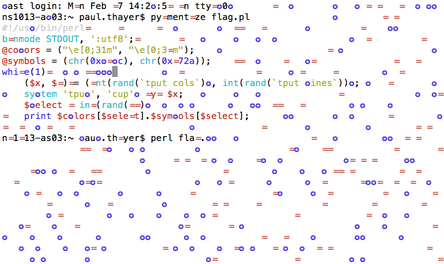
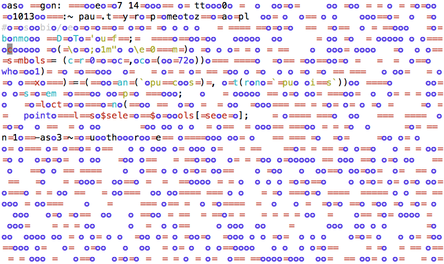
Flag · Páll Thayer
Perl program · 2009
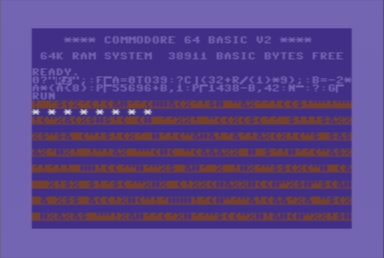
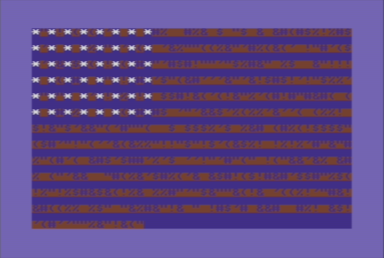
After Jasper Johns · Nick Montfort
one-line Commodore 64 BASIC program · 2013
The C64 in the NYT
My colleague Myke pointed out this New York Times column about the Commodore 64, which waxes nostalgic and also points out how the computer opened up possibilities for new programmers to explore and learn. Myke also pointed out, quite aptly, that the photo, which is supposed to be of a Commodore 64, is actually of a 1541 disk drive. Alas, the Grey Lady, in reference to the rainbow-logoed computer, nods…
“Programs at an Exhibition” Opens March 6
I’ll post more on this soon, but for now, let me invite you to the opening of my & Páll Thayer’s show at the Boston Cyberarts Gallery: 141 Green Street, Jamaica Plain, MA 02130, located in the Green Street T Station on the Orange Line, 617-522-6710.
The opening is 6pm-9pm on Thursday March 6.
The exhibit (which will be up March 6-16) will feature ten programs (five in Commodore 64 BASIC by Nick Montfort, five in Perl by Páll Thayer), each running on its own computer. The programs re-create aspects of the concepts and artistic processes that underlie well-known artworks, not just the visual appearance of those works. They participate in popular and “recreational” programming traditions of the sort that people read about in magazines of the 1970s and 1980s, including _Creative Computing._ Programmers working in these traditions share code, and they also share an admiration for beautiful output. By celebrating such practices, the exhibit relates to the history of art as well as to the ideals of free software and to the productions of the demoscene. By encouraging gallery visitors to explore programming in the context of contemporary art and the work of specific artists, the exhibit offers a way to make connections between well-known art history and the vibrant, but less widely-known, creative programming practices that have been taken up in recent decades by popular computer users, professional programmers, and artists.


Flag · Páll Thayer
Perl program · 2009


After Jasper Johns · Nick Montfort
one-line Commodore 64 BASIC program · 2013
“Poetic Computing,” my Talk at NYU Thursday
Update: Blankets of snow and torrents of sleet have tried to match the intensity of the poster design below. As a result, today’s talk (2/13) is cancelled! NYU is closing at 3pm today. Hopefully there will be another chance before too long…
I don’t always announce my upcoming talks on my blog…
But when I do, they’re promoted by very nice posters.
Upcoming Events at USC, UCLA, MIT, NYU
The Trope Tank has a good deal going on in the next month, as classes at MIT begin. If you’re in LA, the Boston Area, or New York at the right times, please join us…
– January 16 in Los Angeles at USC, my talk “Computational Poetic Models,” SCA Complex, SCI Room 108, 11am
– January 17 in Los Angeles at UCLA, my talk “Ten Cases of Computational Poetics,” M/ELT, YRL Hub, 12pm
– January 21 in Cambridge at MIT, Dr. Piotr Marecki’s talk “Polish Literature in the Digital Age,” 6pm, The Trope Tank
– January 29 in Cambridge at MIT, Commodore 64 BASIC Workshop, The Trope Tank, 2pm-5pm; the workshop is full but we will try to accommodate spectators when we run/screen the results around 4:30pm
– February 13 in New York at NYU, my talk “Poetic Computing,” 239 Greene St Floor 8, 6pm
C64 BASIC Workshop at MIT, January 29, 2-5pm
I am moved by the holiday spirit of MIT’s Independent Activities Period (IAP) to announce a Commodore 64 BASIC programming workshop using original hardware.
[Update: The workshop is now fully subscribed, but I will try to arrange for spectators who would like to join us around 4:30pm to see the results of our work.]
Beginning at 2pm on Wednesday January 29, we will spend about two and half hours working on short BASIC programs. Collaboration will be strongly encouraged; there will be one Commodore 64 provided for each pair of programmers. (If you negotiate with your partner, you may write something individually, however.) It is fine to proceed by modifying programs, and some will be provided for this exact purpose. Programs need not be interactive, but can be. Visual and textual effects will be our focus, but programmers are welcome to work with sound, to develop simple games, or even (gasp!) to write a program that does something useful.
No programming experience (in BASIC, on the Commodore 64, or otherwise) is required. Those who are new to programming can be paired with experienced programmers, if this is suitable to both people. Also, the essentials of BASIC on the Commodore 64 will be described during the workshop. Finally, new programmers can do very interesting work by modifying programs, changing data and parameters and then getting into changing and adding code.
At about 4:30pm we will have a presentation, screening, showcase, or compos of sorts for Commodore 64 BASIC programs in the following three categories:
– One-liner
– (max) 10-line program
– (max) 25-line program
After this workshop, the code developed will be presented and shared on the Web, where it can be run in emulation or by people who have Commodore 64s.
The workshop will take place in my lab at MIT, The Trope Tank, room 14N-233. The site for the lab includes directions for getting there.
The time for the workshop, again, is:
January 29 (Wednesday)
2pm-5pm
I can accommodate 8-10 people, programming in pairs. Reserve a place by sending me an email. Because space is limited, please promise to come to the workshop if you write to reserve a space.
No Code: Null Programs
Just posted: **TROPE-13-03 – No Code: Null Programs** by Nick Montfort, in the Trope Report series (technical reports from my lab the Trope Tank at MIT).
>To continue the productive discussion of uninscribed artworks in Craig Dworkin’s _No Medium,_ this report discusses, in detail, those computer programs that have no code, and are thus empty or null. Several specific examples that have been offered in different contexts (the demoscene, obfuscated coding, a programming challenge, etc.) are analyzed. The concept of a null program is discussed with reference to null strings and files. This limit case of computing shows that both technical and cultural means of analysis are important to a complete understanding of programs – even in the unusual case that they lack code.
Please share and enjoy. And do feel free to leave a comment here if anything to add on this topic, or if you have a question about this report. I’d be glad to continue the discussion of these unusual programs.
Video of Nanowatt Online
A single-loading VIC-20 demo (3583 bytes) presented on November 30, 2013 at Récursion in Montréal. By Nick Montfort, Michael C. Martin, and Patsy Baudoin (nom de nom, mcmartin, baud 1). This video is of the demo running in the Trope Tank at MIT on December 3, 2013.
Tagged on YouTube as Commodore VIC-20, Samuel Beckett, Electronic Literature, Computer (Musical Instrument), and Demoscene. See also the fuller story about Nanowatt with links to executable code.
NaNoGenMo Wraps Up and Prints Out
There are some things I absolutely must mention at this point, to highlight certain of the many interesting outcomes from NaNoGenMo (National Novel Generation Month):
Alice’s Adventures in the Whale, one of two novels created by Leonard Richardson by computationally replacing all the dialog in one novel with the dialog in another:
>Alice was beginning to get very tired of sitting by her sister on the bank, and of having nothing to do: once or twice she had peeped into the book her sister was reading, but it had no pictures or conversations in it, “Can’t sell his head?–What sort of a bamboozingly story is this you are telling me?” thought Alice “Do you pretend to say, landlord, that this harpooneer is actually engaged this blessed Saturday night, or rather Sunday morning, in peddling his head around this town?”
…
>Presently she began again. “Ka-la! Koo-loo!” (she was rather glad there WAS no one listening, this time, as it didn’t sound at all the right word) “Stand up, Tashtego!–give it to him!” (and she tried to curtsey as she spoke–fancy CURTSEYING as you’re falling through the air! Do you think you could manage it?) “Stern all!”
…
>”My God! Mr. Chace, what is the matter?” said poor Alice, and her eyes filled with tears again as she went on, “we have been stove by a whale.” cried Alice, with a sudden burst of tears, “NARRATIVE OF THE SHIPWRECK OF THE WHALE SHIP ESSEX OF NANTUCKET, WHICH WAS ATTACKED AND FINALLY DESTROYED BY A LARGE SPERM WHALE IN THE PACIFIC OCEAN.”
…
>CHAPTER V. Advice from a Caterpillar
>
>The Caterpillar and Alice looked at each other for some time in silence: at last the Caterpillar took the hookah out of its mouth, and addressed her in a languid, sleepy voice.
>
>”I say, pull like god-dam,” said the Caterpillar.
>
>This was not an encouraging opening for a conversation. Alice replied, rather shyly, “There she slides, now! Hurrah for the white-ash breeze! Down with the Yarman! Sail over him!”
Leonard’s other submitted novel used Pride and Prejudice (and Through the Looking Glass). Along similar lines, you may be interested in seeing what Pride and Prejudice looks like without any dialog.
Early in the month, Zarf (Andrew Plotkin) submitted a generated novel that is entirely dialog: Redwreath and Goldstar Have Traveled to Deathsgate.
Ian Renton generated Doctor Who fan fiction using the technique of Bayseian poisoning, which is popular in spam generation. It’s only the only fanficlicious novel; see the generated Austenesque novels of jiko.
I was implicated in inspiring Nif, a palindromic 50,000-word+ novel, the second generated novel submitted (early in the month) by catseye. A remixed and extended version was done by Michael Paulukonis.
Don’t miss Aaron Reed’s Agressive Passive, which details conversation between six housemates about maintaining the cleanliness of their domicile.
And finally, my entry is World Clock, which briefly describes something happening, at some location around the world, at each minute of a day.
The overall “site” for NaNoGenMo, which was the fervent brainchild of Darius Kazemi, is, by the way, this humble GitHub repository.
Nanowatt
At Récursion (the Montréal demoparty), we (Nick Montfort, Michael C. Martin, and Patsy Baudoin) released Nanowatt, a single-loading VIC-20 demo.
You can download it and run it using a VIC-20 emulator (or, of course, an actual VIC-20). I run it in VICE on my Ubuntu system by typing “xvic nw” from the directory that contains the “nw” file. If it’s more convenient, you can also download a d64 disk image with Nanowatt on it and load “nw” from there.
It produces 8 KB of English text quoted exactly from Samuel Beckett’s second novel, Watt.
And it produces 8 KB of French text quoted exactly from the French translation of Samuel Beckett’s second novel, Watt.
And the entire demo (including two songs, sound system, code for decompression and display of text, and explanations and greetings at the end) is 3.5 KB: 3583 bytes.
When possible, I will upload a video of the demo running.
This rather esoteric demo was awarded 2nd place (out of 3 entries).
I also got 4th place (out of 5) for my one-line BASIC program that was done as a fast demo, based on today’s theme: “weaving.”
Demoscene.
UPDATE: You can run Nanowatt without leaving the comfort of your browser. First, copy this URL into your copy-and-paste buffer: << http://nickm.com/poems/nw >>. Then, go to the page for JS VIC-20. Select the “Storage” menu from the top and choose the option at the bottom of the list, “Carts/Programs,” and choose the top option, “Load Cart from URL.” Finally, paste in the URL that you copied and watch the demo run.
‘NOTHER UPDATE: Video of the demo running on a VIC-20 has been posted.
It’s a Good Word. Maine.
Just back from several travels, I’ve found that there’s a video record online of me, Patsy Baudoin, and John Bell presenting 10 PRINT at the University of Maine way back in April of this year. In our presentation, we answer questions and discuss the origin of the 10 PRINT project and the nature of our collaboration. And I do some livecoding. Pretty often, actually.
Please note that 10 PRINT CHR$(205.5+RND(1)); : GOTO 10 is available as a beautiful MIT Press book, designed by our co-author Casey Reas, ans also as a free PDF.
Here’s the video of our University of Maine presentation on the “10 PRINT” program and book.
Parallelograms
A remarkable hypertextual video essay, Parallelograms, has been posted by Jeffrey Scudder. It is composed of an intriguing collections of clips, and includes some fascinating video quotation of (e.g.) Marshall McLuhan, Douglas Rushkoff, Ted Nelson, Alan Kay, and Chris Crawford. Not to mention my colleague Hal Albelson in a wizard hat. Also, I couldn’t help but notice that it shows the 10 PRINT program executing and features a shot of the book A Million Random Digits with 100,000 Normal Deviates.
If these matters at all interest you, do read/watch this video meditation on digital media, society, materiality, matter, the body, and (as I read/watch it) how the computer, whatever its limits, may have still-untapped potential for empowerment and change.
Software Freedom Day
Next Saturday (September 21, 2013) is Boston Software Freedom Day. This event, like the Boston Festival of Independent Games yesterday, is also taking place in Cambridge rather than Boston – at Cambridge College, 1000 Mass Ave, between Central and Harvard Squares.
Come by to hear about and discuss freedoms on the computer and online, privacy, and government transparency. I’ll offer one of the very quick lightning talks at the end of the day, discussing some of the history of creative computing and its relationship to software freedom.
The event is not only libre, but also no-cost. And the cake to celebrate the 30th anniversary of GNU is not a lie.
Learn Brogramming
The Deletionist
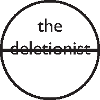 I’m pleased to announce the release of a project that I’ve been working on with Amaranth Borsuk and Jesper Juul for the past two years: The Deletionist. This is a bookmarklet (easily added to the bookmark bar in one’s browser) that automatically creates erasure poetry from any page on the World Wide Web, revealing an alterate mesh of texts called the Worl. Amaranth and I presented The Deletionist for the first time today at E-Poetry in London, at Kingston University.
I’m pleased to announce the release of a project that I’ve been working on with Amaranth Borsuk and Jesper Juul for the past two years: The Deletionist. This is a bookmarklet (easily added to the bookmark bar in one’s browser) that automatically creates erasure poetry from any page on the World Wide Web, revealing an alterate mesh of texts called the Worl. Amaranth and I presented The Deletionist for the first time today at E-Poetry in London, at Kingston University.
House of Leaves of Grass
What miracle is this? This giant tree.
It stands ten thousand feet high
But doesn’t reach the ground. Still it stands.
Its roots must hold the sky.
O
HYMEN! O hymenee!
Why do you tantalize me thus?
O why sting me for a swift moment only?
Why can you not continue? O why do you now cease?
Is it because, if you continued beyond the swift moment, you would soon certainly kill me?
[This “House of Leaves of Grass” is a 24K poetry generator that produces about 100 trillion stanzas. Vast, it contains multitudes; it is bigger on the inside than it is on the outside. By Mark Sample, based on “Sea and Spar Between.”]


